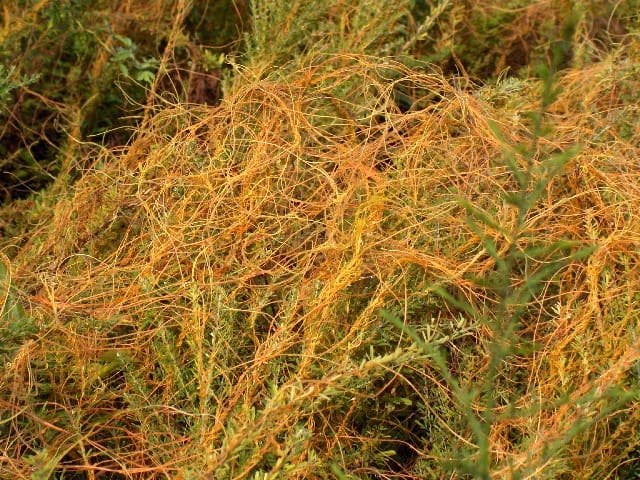Source(s): Mark Czarnota
Dodder (Cuscuta spp.) is a parasitic weed that infects a wide range of herbaceous and woody plant material. There are approximately 12 species of dodder and each species has a different host range. Dodder is generally brought into ornamental planting via infected plant material.
Growth Characteristics
Dodder is a rootless, leafless, parasitic flowering plant. It is in the morning glory (Convolvulaceae) family. Dodder flowers and produces seed like any other flowering plant. Seeds can remain dormant in the soils for years before germinating. Under the right conditions, dodder seed will germinate, sending up a tendril that attaches to a suitable host plant. If no suitable host is available, the plant will die within a few days. Dodder attaches itself to the host plant’s vascular system with a peg-like haustoria. Once attached, the root system of the dodder plant shrivels and the plant feeds off the host. Dodder contains no green tissues because it does not need to photosynthesize and produce its own food. The stem color of dodder is generally yellow to orange, but can also be shades of red or white. Flowers are small, white or pink, and usually born in clusters.
Host Plants
Dodder infects a wide range of plants, including plants in the Asteraceae family (chrysanthemums, marigolds and sunflowers), Fabaceae family (alfalfa, clovers, soybeans and vetches), and the Ericaceae family (azaleas and rhododendrons).
Control
Remove all plants or portions of plants infected by dodder. Ideally it should be removed before the dodder flowers and produces seed. To date, dodder cannot be controlled through a selective post emergent herbicide application. However if the host plant is killed, the dodder plant will also die. Dodder seed can be controlled with pre emergent herbicides (check label to see if these herbicides are safe to host ornamentals) and soil sterilization.
Pesticide Precautions
It is the responsibility of the pesticide user to observe all directions, restrictions and precautions on pesticide labels. It is dangerous, wasteful and illegal to do otherwise. Store all pesticides in original containers with labels intact and behind locked doors. Use pesticides at correct label dosage and intervals to avoid illegal residues or injury to plants and animals. Use pesticides carefully to avoid drift or contamination of non- target areas. Surplus pesticides and containers should be disposed of in accordance with label instructions so contamination of water and other hazards will not result. Follow directions on the pesticide label regarding restrictions as required by State or Federal Laws and Regulations. Avoid any action that may threaten an endangered species or its habitat.
KEEP PESTICIDES OUT OF THE REACH OF CHILDREN!
Center Publication Number: 216
- Florida Betony Control - September 24, 2013
- Poison Ivy: Leaves of Three – Let it Be! - September 23, 2013
- Dodder - September 23, 2013
